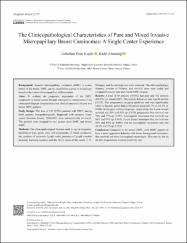| dc.contributor.author | Eren Kupik, Gülnihan | |
| dc.date.accessioned | 2022-07-27T12:56:15Z | |
| dc.date.available | 2022-07-27T12:56:15Z | |
| dc.date.issued | 2022 | en_US |
| dc.identifier.citation | Eren Kupik G, Altundağ K. The Clinicopathological Characteristics of Pure and Mixed Invasive Micropapillary Breast Carcinomas: A Single Center Experience. Balkan Med J. 2022 Jul 22;39(4):275-281. doi: 10.4274/balkanmedj.galenos.2022.2022-4-7. PMID: 35872645. | en_US |
| dc.identifier.issn | 2146-3123 / 2146-3131 | |
| dc.identifier.uri | https://hdl.handle.net/20.500.12809/10151 | |
| dc.description.abstract | Background: Invasive micropapillary carcinoma (IMPC) is a rare tumor of the breast. IMPC can be classified as a pure or mixed type based on the extent of micropapillary differentiation.
Aims: To evaluate the prognostic importance of the IMPC component in breast cancer through retrospective comparison of the clinicopathological characteristics and clinical outcomes of pure and mixed IMPC patients.
Study design: The data of 147 (2.2%) patients with IMPC among 6648 patients histopathologically diagnosed with invasive breast cancer between January 2000-2022 were retrospectively reviewed. The patients were assigned to two groups: pure IMPC and mixed IMPC.
Methods: The clinicopathological features such as age at diagnosis, histological type, grade, size, and components of mixed carcinoma, the numbers of metastatic lymph nodes, presence of lymph vascular invasion, hormone receptor, and the Her-2 status of the tumor, T, N, M stages, and the survival rates were reviewed. The clinicopathologic features, patterns of failures, and survival rates were coded and compared between pure and mixed IMPC patients.
Results: A total of 45 patients (30.6%) had pure and 102 patients (69.4%) had mixed IMPC. The median follow-up time was 46 months (3-178). The progesterone receptor positivity rate was significantly lower in the pure group than in the mixed group (66.7% vs. 83.3%, p: 0.024). In the pure and mixed groups, respectively, the 5-year overall survival was 90% and 91% (p: 0.839); progression-free survival was 70% and 77% (p: 0.537); locoregional recurrence-free survival was 86% and 95% (p: 0.043); 5-year distant metastasis-free survival was 88% and 83% (p: 0.066), and the locoregional recurrence rate was 10.3% and 2% (p: 0.052).
Conclusion: Compared to the mixed IMPC, pure IMPC appears to have a more aggressive behavior with lower locoregional recurrence-free survival and more locoregional recurrences. This may be due to the low progesterone receptor positivity rate. | en_US |
| dc.item-language.iso | eng | en_US |
| dc.publisher | GALENOS YAYINCILIK | en_US |
| dc.relation.isversionof | 10.4274/balkanmedj.galenos.2022.2022-4-7 | en_US |
| dc.item-rights | info:eu-repo/semantics/openAccess | en_US |
| dc.subject | Invasive micropapillary carcinoma (IMPC) | en_US |
| dc.title | The Clinicopathological Characteristics of Pure and Mixed Invasive Micropapillary Breast Carcinomas: A Single Center Experience | en_US |
| dc.item-type | article | en_US |
| dc.contributor.department | MÜ, Tıp Fakültesi, Eğitim ve Araştırma Hastanesiü | en_US |
| dc.contributor.authorID | 0000-0002-3315-3893 | en_US |
| dc.contributor.institutionauthor | Eren Kupik, Gülnihan | |
| dc.identifier.volume | 39 | en_US |
| dc.identifier.issue | 4 | en_US |
| dc.identifier.startpage | 275 | en_US |
| dc.identifier.endpage | 281 | en_US |
| dc.relation.journal | Balkan Medical Journal | en_US |
| dc.relation.publicationcategory | Makale - Uluslararası Hakemli Dergi - Kurum Öğretim Elemanı | en_US |


















